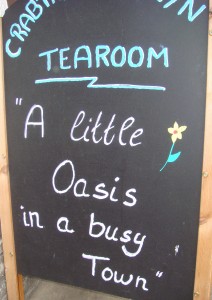 Mr. Briggs
Mr. Briggs
Before I meet Mrs. Briggs and Dennis in the waiting room, I stop for a bracing tea and scone, then find my way to the hospital vending machines. I don’t want to rush into this depressing situation. Nothing looks good in the machines, but I get three coffees and three Kit Kat bars anyway. Who knows how long we’ll be here. Is there a person on this earth who can refuse coffee and candy bars?
Juggling the cups and bars, I walk into the waiting room, empty except for Dennis and Mrs. Briggs huddled in quiet conversation. They look up as I approach.
“Is one of those for me?†Dennis says rather too loudly.
“Of course, my love.â€
I hand over coffees and Kit Kats.
“I can’t have this, dear,†says Mrs. Briggs. “I’m diabetic, but I’ll save it for Oscar.â€
There are industrious sounds of crinkling, tearing, and chewing. Chocolate has a way of putting things in perspective.
“What’s the news? There was a turn for the worse?†I say as Dennis crumples the Kit Kat wrapper. (Continued)

The Royal Crescent, Bath, Somerset
Jane Austen’s family spent time and rented rooms and floors of rooms from time to time in Bath, Somerset, England. The refurbished Roman baths provided entertainment and a promise of healing any and all ills, while the Royal Crescent and other stone “terraces” (apartment complexes) provided high-status accommodations where the Austen family could promenade in the parks and along the walks and pathways.
But, though Jane’s family enjoyed pride and status for some years, her clergyman father George died in 1805, and the family suddenly couldn’t afford to live in nice apartments or rooms at the top of the hill.
Their first descent from their hilltop residence was to
Their final descent was to some rooms on Trim Street, a block-long street (more of a lane, really) down by the railway station and the Avon River, where I walked on a recent Monday afternoon. Even in 2014, Trim looked industrial and rather grim. (Continued)
A turn for the worse
Ti Jean is my gray striped rescue tomcat. He’s 17 years old, I think, but I’m not sure. My vet, Mr. Mukhurgee, says Ti Jean is in good health but a little overweight. At each visit, Mr. Mukhurgee also says he’s going to retire the next month. I tell him there is no way he can retire. He has to wait till after Ti Jean has died.
Ti Jean is also the only connection to my ex-husband. Robert Perhaps is British, and he and I were married for six years. We had a fairly amicable divorce except when it came to the cat. Robert wanted Ti Jean and I insisted on having Ti Jean, so we have to share him; right now it’s my six months with that little contentious ball of fluff till September 30. Dr. Mukhurjee says maybe I overfeed Ti Jean because I feel so awful that he has also to live with Robert. I’m the only one who takes Ti Jean to the vet. (Continued)
I think we’re the only guests in this hotel. We do hear other people from time to time, but they only seem to stay one night at a time. And for some UNKNOWN REASON these people are housed right next door to us. Why the staff can’t put at least one room between us and these nightlies, I do not know. There was the guy with a bad cough, the two girls who arrived at 2 a.m. and talked loudly till 4, and last night the guy who yakked on his phone. On our last night, it would be great if everybody else on our floor had already checked out.
Last fall when we booked this room, we must have been looking only at price and location, because otherwise this is a tired old dump. The basics are here–beds, carpeting, toilet, shower, hook on the bathroom door. But modern amenities are absent. (Continued)
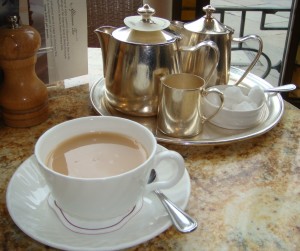 My mother called me Fi Fi and my father called me Pumpkin, but to my neighbors and writing students, I’m Miss Ophelia Perhaps, neighborhood detective. I live with a very difficult cat named Ti Jean in the tiny room of some family friends in Summertown, just north of Oxford.
My mother called me Fi Fi and my father called me Pumpkin, but to my neighbors and writing students, I’m Miss Ophelia Perhaps, neighborhood detective. I live with a very difficult cat named Ti Jean in the tiny room of some family friends in Summertown, just north of Oxford.
After a brisk walk down Banbury every morning, Dennis brings me coffee with a slice of cake every day at the Albion Beatnik Café. I sit there in his front room and talk with old Mr. Briggs most mornings, except Sundays. That’s when his wife makes him go to church.
I spend most evenings over glasses of Pinot Gris in the Oxford Wine Café. In between the two cafes, I teach people to write and occasionally my neighbors ask me to help them solve mysteries.
But this rainy Wednesday morning, something’s wrong. The Beatnik is still locked at 10:14 a.m. Where’s Dennis? And where’s Mr. Briggs? Oh, hold on, there’s a note. “Emergency. Back later.†This can’t be right. And who wrote the note? (Continued)
It was in the breakfast room of my small Oxford guest house where I started thinking about curtains. My server of corn flakes and coffee kept walking back into the kitchen, pulling the curtains behind her, closing off her work area from the public space where hotel guests were seating themselves at small, round, perfectly set tables. The server would walk back into the breakfast space with jugs of orange and apple juice, individual French presses of coffee, and bowls of corn flakes or cocoa puffs. Then she’d ask if we wanted white or brown bread, strawberry or peach yoghurt, and walk back into her curtained space.
Curtains separate public spaces from private spaces, the inner from the outer, the higher from the lower, the servant from the master, the rich from the poor, upper classes from the lower classes, the day from the night, and the server from the servee.
My Air Canada flights had curtains separating the first class seats from mine in economy. If I’d dared to walk past those curtains into first class, I’m sure I would have quickly been redirected to my economy seat. The curtains were a class wall I had not paid to breach. (Continued)
Harry and Tonto (1974), Larger than Life (1996), and Duck (2009) are grouped together because all feature older men with animal companions. Themes of loneliness, masculinity, aging, and a sense of place pervade all three films.
1. Art Carney (famous as Ed Norton on The Honeymooners) travels west with his orange tabby cat, Tonto, in Harry and Tonto. Harry is a retired New York teacher in his 70s in New York, where he’s lived his whole life. Harry drives across the United States with Tonto, visiting his children, and seeing a world he never had time to see before. Carney won a Best Actor Oscar for his performance. (Continued)
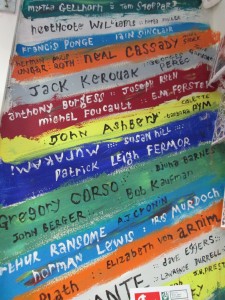 It was an unassuming storefront with a killer name, Albion Beatnik Cafe, and an unassuming drizzly morning watched a couple of American drowned rats enter the premises. The Beatnik Cafe was the kind of place to peruse, pursue, and, hopefully, purchase for the pleasure of language. Our eyes swept the cubby shelves of literary wonders from the 20s, 30s, 40s, 50s . . . though not any Nelson Algren works (such as Man with the Golden Arm). I found myself suddenly wanting to peruse this Chicago author’s books after thumbing through Simone de Beauvoir’s The Mandarins. Simone and Nelson loved each other across Paris-Chicago-Paris and back again. Were they Beatniks? Their outrageously good writing and double world-war auras certainly put them firmly in the same era.
It was an unassuming storefront with a killer name, Albion Beatnik Cafe, and an unassuming drizzly morning watched a couple of American drowned rats enter the premises. The Beatnik Cafe was the kind of place to peruse, pursue, and, hopefully, purchase for the pleasure of language. Our eyes swept the cubby shelves of literary wonders from the 20s, 30s, 40s, 50s . . . though not any Nelson Algren works (such as Man with the Golden Arm). I found myself suddenly wanting to peruse this Chicago author’s books after thumbing through Simone de Beauvoir’s The Mandarins. Simone and Nelson loved each other across Paris-Chicago-Paris and back again. Were they Beatniks? Their outrageously good writing and double world-war auras certainly put them firmly in the same era.
The proprietor appeared, appropriately unhinged (the hair helped), with two French presses. This was the kind of shop that could convince you to linger in Oxfordshire a few more weeks. Travelers are reluctant book-buyers, but I did buy the coffee and fully appreciated the public offerings, like the Beatnik reading group and open mics. The whole choosing of the coffee mugs from the narrow shelves was also a lovely touch. This perfect, quirky, and thank-god-it’s-off-the-academic-path kind of store was a place where someone could discuss writing and weather, Algren and anarchy, poetry and deals made with devil Amazon.com. (Continued)
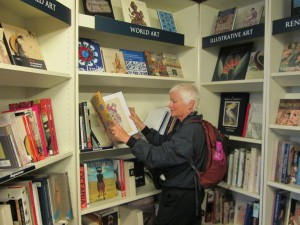
In Blackwell’s Art and Poster
The artist on vacation is not necessarily constantly sketching. I’m not Jack Kerouac with his small notebook, pulling it out, writing it down, stuffing it back into a jeans pocket. Oh, artists observe all right, and we may take photos for future use. The Midlands of England have perhaps every single tint, shade, hue, and swatch of green perceived and named.
I’m carrying a fat little sketchbook for when the mood strikes, and on yesterday’s mostly sunny day I could have been drawing plein air. But today was all gray rain and drizzle, so art for me came in published book form.
Blackwell’s Art and Poster was a visual cacophony of large-format books on art movements, artists, and criticism. I particularly enjoyed leafing through some hefty books on Islamic art. (Continued)
So his name was Elliot (not Elias) Rodger, and he was a junior at UCSB (mascot: the gaucho). I’m sure there will be interviews and comments coming from students and professors. Would his choice of major have given us any clues? Will Americans say, “At least he was a Brit and not one of us.”
The May 25 Daily Mirror newspaper front page headline was “Shooting rampage horror: Brit student kills 6 after he’s snubbed by girls.” And then a page 4-5 spread by Christopher Bucktin started by shouting in 2-inch tall ink, “I will slaughter every single blonde slut I see.” A collage of photos and a screen shot from Rodger’s Facebook page were accompanied by a sidebar with Elliot’s grandfather George Rodger’s photo of Jewish survivors at the liberation of Bergen-Belsen concentration camp. Wait, what? (Continued)
 Mr. Briggs
Mr. Briggs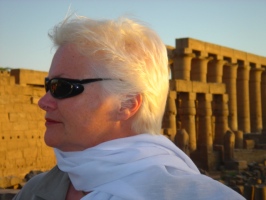

 My mother called me Fi Fi and my father called me Pumpkin, but to my neighbors and writing students, I’m Miss Ophelia Perhaps, neighborhood detective. I live with a very difficult cat named Ti Jean in the tiny room of some family friends in Summertown, just north of Oxford.
My mother called me Fi Fi and my father called me Pumpkin, but to my neighbors and writing students, I’m Miss Ophelia Perhaps, neighborhood detective. I live with a very difficult cat named Ti Jean in the tiny room of some family friends in Summertown, just north of Oxford. It was an unassuming storefront with a killer name, Albion Beatnik Cafe, and an unassuming drizzly morning watched a couple of American drowned rats enter the premises. The Beatnik Cafe was the kind of place to peruse, pursue, and, hopefully, purchase for the pleasure of language. Our eyes swept the cubby shelves of literary wonders from the 20s, 30s, 40s, 50s . . . though not any Nelson Algren works (such as Man with the Golden Arm). I found myself suddenly wanting to peruse this Chicago author’s books after thumbing through Simone de Beauvoir’s The Mandarins. Simone and Nelson loved each other across Paris-Chicago-Paris and back again. Were they Beatniks? Their outrageously good writing and double world-war auras certainly put them firmly in the same era.
It was an unassuming storefront with a killer name, Albion Beatnik Cafe, and an unassuming drizzly morning watched a couple of American drowned rats enter the premises. The Beatnik Cafe was the kind of place to peruse, pursue, and, hopefully, purchase for the pleasure of language. Our eyes swept the cubby shelves of literary wonders from the 20s, 30s, 40s, 50s . . . though not any Nelson Algren works (such as Man with the Golden Arm). I found myself suddenly wanting to peruse this Chicago author’s books after thumbing through Simone de Beauvoir’s The Mandarins. Simone and Nelson loved each other across Paris-Chicago-Paris and back again. Were they Beatniks? Their outrageously good writing and double world-war auras certainly put them firmly in the same era.